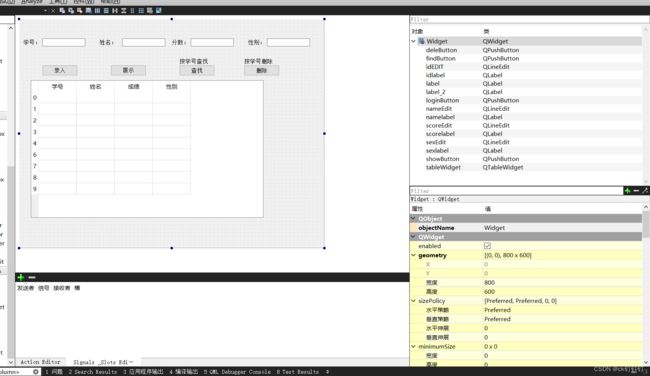QT连接数据库
目录
数据库
数据库基本概念
常用的数据库
SQLite3基础
SQLite特性:
QT连接数据库
1.1 QT将数据库分为三个层次
1.2 实现数据库操作的相关方法
sql语句(常用)
1)创建表格
2)删除表格
3)插入记录
4)查看记录
5)修改记录
6)删除记录
7)主键(primary key)
8)拷贝
9)增加列
10)修改表名
11)修改字段名(列名)
12)删除列
通过数据库实现简易的学生管理系统
ui界面
配置文件
头文件 (.h文件)
源文件
main.cpp文件
实现效果:
数据库
数据库基本概念
- 数据(Data)
能够输入计算机并能被计算机程序识别和处理的信息集合数据库 (Database)
数据库是在数据库管理系统管理和控制之下,存放在存储介质上的数据集合
-
常用的数据库
1)大型数据库Oracle公司是最早开发关系数据库的厂商之一,其产品支持最广泛的操作系统平台。目前Oracle关系数据库产品的市场占有率名列前茅。IBM 的DB2是第一个具备网上功能的多媒体关系数据库管理系统,支持包Linux在内的一系列平台。中型数据库Server是微软开发的数据库产品,主要支持windows平台。
2)小型数据库mySQL是一个小型关系型数据库管理系统,开发者为瑞典MySQL AB公司,2008年被Sun公司收购,开放源码。
3)基于嵌入式的数据库
基于嵌入式Linux的数据库主要有SQLite, Firebird, Berkeley DB, eXtremeDBFirebird是关系型数据库,功能强大,支持存储过程、SQL兼容等SQLite关系型数据库,体积小,支持ACID事务Berkeley DB中并没有数据库服务器的概念,它的程序库直接链接到应用程序中 eXtremeDB是内存数据库,运行效率高
-
SQLite3基础
www.sqlite.org
SQLite的源代码是C,其源代码完全开放。SQLite第一个Alpha版本诞生于2000年5月。 他是一个轻量级的嵌入式数据库。
SQLite特性:
- 零配置一无需安装和管理配置;
- 储存在单一磁盘文件中的一个完整的数据库;
- 数据库文件可以在不同字节顺序的机器间自由共享;
- 支持数据库大小至2TB;
- 足够小,全部源码大致3万行c代码,250KB;
- 比目前流行的大多数数据库对数据的操作要快;
QT连接数据库
1.1 QT将数据库分为三个层次
1> 数据库驱动层:QSqlDriver、QSqlDriverCreator、QSqlDriverCreatorBase、QSqlDriverPlugin
2> sql接口层:QSqlDatabase、QSqlQuery、QSqlRecord、QSqlError
3> 用户接口层:提供一些模型QSqlQueryModel、QSqlTableModel、QSqlRelationalTableModel
1.2 实现数据库操作的相关方法
1、添加数据库:[static] QSqlDatabase QSqlDatabase::addDatabase(QSqlDriver *driver, const QString &connectionName = QLatin1String(defaultConnection))
QSQLITE
SQLite version 3 or above
2、设置数据库名称:void QSqlDatabase::setDatabaseName(const QString &name)
3、包含数据库:bool QSqlDatabase::contains(const QString &connectionName = QLatin1String(defaultConnection))
4、打开数据库:bool QSqlDriver::open(const QString &db)
5、关闭数据库:void QSqlDatabase::close()
6、错误信息:QSqlError QSqlDatabase::lastError()
7、sql语句执行:构造一个QSqlQuery类对象,调用其成员函数exec,执行sql语句:bool QSqlQuery::exec(const QString &query)
8、bool QSqlQuery::next():遍历查询结果的函数sql语句(常用)
本项目使用sqlite3,不区分大小写
1)创建表格
create table 表名 (字段名 数据类型, 字段名 数据类型);
create table if not exists 表名 (字段名 数据类型, 字段名 数据类型);
eg:
CREATE TABLE stu (id int, name char, score float);
CREATE TABLE if not exists stu1 (id int, name char, score float);
注意:数据库不支持严格的数据类型检查,数据类型写错了,创建是能够成功的,不会有错误提示;2)删除表格
drop table 表名;
eg:
drop table stu1;3)插入记录
字符串类型可以使用单引号,也可以使用双引号
1) 全字段插入
insert into 表名 values (数据1, 数据2, 数据3);
eg:
INSERT INTO stu VALUES (2, 'ls', 99);
INSERT INTO stu VALUES (1, "zs", 59);
注意:
1.数据输入的顺序要与创建时候字段的顺序一致;
2) 部分字段插入
insert into 表名 (字段名1, 字段名2) values (数据1, 数据2);
eg:
INSERT INTO stu (id, name) values (9, 'ww');
注意:
1.数据的顺序要与指定的字段名1,字段名2对应;4)查看记录
.header on 打开表头
.mode column 对齐
在终端输入shell指令:sqlitebrowser sq.db 图形化界面
1) 查看所有记录
select * from 表名;
eg:
SELECT * FROM stu;
2) 查看某几行
select * from 表名 where 限制条件;
逻辑与 and 逻辑或 or
eg:
SELECT * FROM stu WHERE id<3 AND score>90;
SELECT * FROM stu WHERE id<2 OR id>3;
3) 查看某几列
select 字段1, 字段2 from 表名;
select 字段1, 字段2 from 表名 where 限制条件;
eg:
SELECT id, name FROM stu;
SELECT id, name FROM stu WHERE score>90;5)修改记录
update 表名 set 字段=数值 where 限制条件;
eg:
UPDATE stu SET score=60 WHERE id=1;6)删除记录
delete from 表名 where 限制条件;
eg:
DELETE FROM stu WHERE id=1;
delete from stu; 删除表格中的所有数据;7)主键(primary key)
primary key 主键;
create table 表名(字段名 数据类型 primary key, 字段名 数据类型);
primary key主键:唯一标识表格中的每一条记录;
例如:id字段为主键,当表格中有id==1的记录时,不允许再插入id为1的记录了;
eg:
CREATE TABLE stu (id int PRIMARY KEY, name char, score float);
注意:主键的值必须唯一。每一张表格都应该设置一个主键,而且只能设置一个。8)拷贝
从a中拷贝所有数据到b中:
create table b as select * from a;
从a中拷贝指定字段到b中:
create table b as select 字段,字段,字段 from a;
CREATE TABLE stu1 AS SELECT * FROM stu;
CREATE TABLE stu2 AS SELECT id, name, score FROM stu;9)增加列
alter table 表名 add column 字段名 数据类型;
alter table stu add column score int;10)修改表名
alter table 旧表名 rename to 新表名;
alter table stu rename to stuinfo;11)修改字段名(列名)
不支持直接修改列名
1.将表重新命名(a改成b)
alter table stuinfo rename to stu;
2.新建修改名字后的表(新建一个a)
create table stuinfo (name char, age1 int, sex char, score int);
3.从旧表b中取出数据,插入到新表a中;
insert into stuinfo select * from stu;12)删除列
不支持直接删除列;
1.创建一个新表b,并复制旧表a需要保留的字段信息;
create table stu as select name, age1, sex from stuinfo;
2.删除旧表a;
drop table stuinfo;
3.修改新表b的名字a;
alter table stu rename to stuinfo;通过数据库实现简易的学生管理系统
ui界面
配置文件
头文件 (.h文件)
#ifndef WIDGET_H
#define WIDGET_H
#include
#include //数据库类
#include //执行sql语句对应的类
#include //记录类
#include //消息对话框类
#include
#include
QT_BEGIN_NAMESPACE
namespace Ui { class Widget; }
QT_END_NAMESPACE
class Widget : public QWidget
{
Q_OBJECT
public:
Widget(QWidget *parent = nullptr);
~Widget();
private slots:
void on_loginButton_clicked();
void on_showButton_clicked();
void on_findButton_clicked();
void on_deleButton_clicked();
void deletelist(); //清空内容函数
private:
Ui::Widget *ui;
//定义一个数据库对象
QSqlDatabase db;
};
#endif // WIDGET_H
源文件
#include "widget.h"
#include "ui_widget.h"
Widget::Widget(QWidget *parent)
: QWidget(parent)
, ui(new Ui::Widget)
{
ui->setupUi(this);
//判断数据库对象是否包含了自己使用的数据库 Student.db
//如果没有这个数据库就需要添加一个数据库
if(!db.contains("Student.db"))
{
//添加一个数据库
//函数原型: static QSqlDatabase addDatabase(QSqlDriver* driver);
//参数:数据库的版本
//返回值:添加的数据库
db = QSqlDatabase::addDatabase("QSQLITE"); //表明用的是sqlite3及以上版本的数据库
//给数据库命名
db.setDatabaseName("Student.db");
}
//打开数据库
if(!db.open())
{
QMessageBox::information(this, "提示", "数据库打开失败");
return;
}
//此时说明数据库已经创建出来并打开了,就可以创建数据表了
//创建数据表需要使用sql语句,需要使用QSQLQuerry类对象来完成
//准备sql语句
QString sql = "create table if not exists myTable("
"number integer primary key autoincrement," //序号自增
"id integer," //学号,是整形
"name varchar(10)," //学生姓名
"score integer," //成绩
"sex varchar(4))"; //性别
//定义语句执行者
QSqlQuery querry;
//使用querry执行sql语句
if(!querry.exec(sql))
{
QMessageBox::information(this, "失败", "创建表失败");
}else
{
QMessageBox::information(this, "成功", "创建表成功");
}
}
Widget::~Widget()
{
delete ui;
}
void Widget::deletelist()
{
ui->idEDIT->clear();
ui->nameEdit->clear();
ui->sexEdit->clear();
ui->scoreEdit->clear();
ui->tableWidget->clear();
}
//录入按钮对应的槽函数
void Widget::on_loginButton_clicked()
{
//获取ui界面中要存入数据库的字符串
int ui_id = ui->idEDIT->text().toInt(); //获取ui界面的学号
QString ui_name = ui->nameEdit->text(); //获取ui界面上的姓名
int ui_score = ui->scoreEdit->text().toInt(); //获取ui界面上的成绩
QString ui_sex = ui->sexEdit->text(); //获取ui界面上的性别
if(ui_id==0 || ui_name.isEmpty() || ui_score==0 || ui_sex.isEmpty())
{
QMessageBox::information(this,"提示","请将学生信息填写完整");
return;
}
//准备sql语句
QString sql = QString("insert into myTable(id,name,score,sex)"
"values(%1, \"%2\", %3, \"%4\")"
).arg(ui_id).arg(ui_name).arg(ui_score).arg(ui_sex);
//定义语句执行者
QSqlQuery querry;
//使用querry执行sql语句
if(!querry.exec(sql))
{
QMessageBox::information(this, "失败", "录入失败");
}else
{
QMessageBox::information(this, "成功", "录入成功");
deletelist();
}
}
//展示按钮对应的槽函数
void Widget::on_showButton_clicked()
{
deletelist();
//准备sql语句
QString sql = "select * from myTable";
//定义语句执行者
QSqlQuery querry;
//使用querry执行sql语句
if(!querry.exec(sql))
{
QMessageBox::information(this, "失败", "展示失败");
return;
}
//此时,将查找到的所有结果,全都放在querry对象中了
//可以通过next函数不断遍历查询到的结果
//querry.next()有数据为真,否则为假
int i = 0; //用来记录行号
while(querry.next()) //代表行
{
//遍历的就是任意一组记录:queery.record
// qDebug() << querry.record(); //所有数据输出
//要找到每条记录中的每个使用数据
//qDebug() << querry.record().value(2); //把第二列的数据输出
//querry.record().value(2).toString(); //将记录的某一项的数据转变成字符串
//获取从数据库中查询到的有几列 //数据项的个数
//querry.record().count(); //返回当前记录对应数据项的个数
//将数据库中的表格展示到ui界面
//要传参行和列还要一个QTableWidgetItem的指针
//ui->tableWidget->setItem()
for(int j=0; jtableWidget->setItem(i,j,new QTableWidgetItem(querry.record().value(j+1).toString()));
}
i++; //进行下一行
}
}
//查找按钮对应的槽函数
void Widget::on_findButton_clicked()
{
QString sql = QString("SELECT * FROM myTable WHERE id=%1").arg(ui->idEDIT->text().toInt());
//qDebug() << sql;
QSqlQuery querry;
//使用querry执行sql语句
if(!querry.exec(sql))
{
//qDebug() << querry.lastError();
QMessageBox::information(this, "失败", "查找失败");
return;
}
deletelist();
//此时,将查找到的所有结果,全都放在querry对象中了
//可以通过next函数不断遍历查询到的结果
//querry.next()有数据为真,否则为假
int i = 0; //用来记录行号
while(querry.next()) //代表行
{
for(int j=0; jtableWidget->setItem(i,j,new QTableWidgetItem(querry.record().value(j+1).toString()));
}
i++; //进行下一行
}
}
//删除按钮对应的槽函数
void Widget::on_deleButton_clicked()
{
QString sql = QString("DELETE FROM myTable WHERE id=%1").arg(ui->idEDIT->text().toInt());
//qDebug() << sql;
QSqlQuery querry;
//使用querry执行sql语句
if(!querry.exec(sql))
{
//qDebug() << querry.lastError();
QMessageBox::information(this, "失败", "删除失败");
return;
}else
{
QMessageBox::information(this, "成功", "删除成功");
deletelist();
}
}
main.cpp文件
#include "widget.h"
#include
int main(int argc, char *argv[])
{
QApplication a(argc, argv);
Widget w;
w.show();
return a.exec();
}

